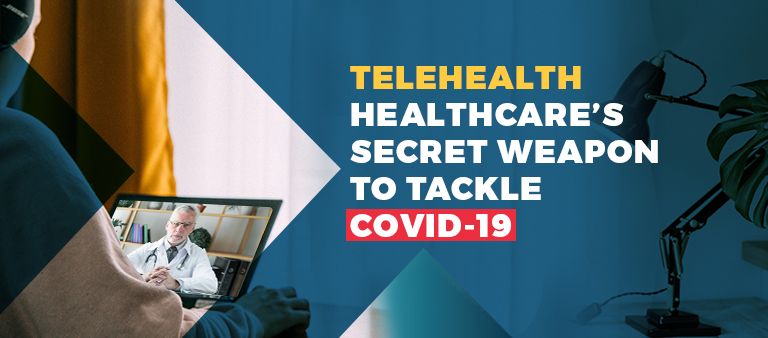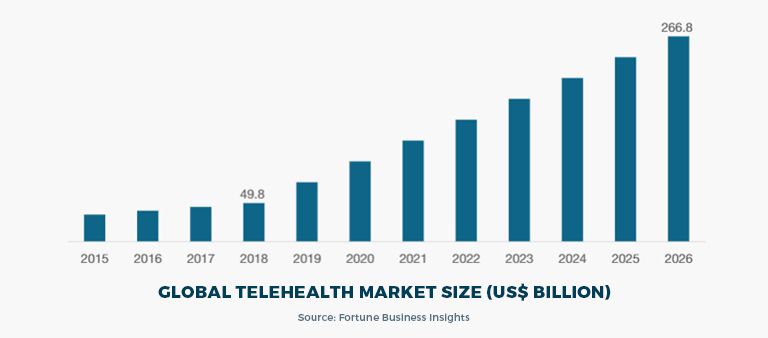As the novel Coronavirus circles the globe, public health institutions such as the World Health Organization (WHO), The Food and Drug Administration (FDA), and the Centers for Disease Control and Prevention (CDC) are urging people who feel unwell to first consult with healthcare service providers remotely, via voice or video call.
The motive behind this urge is to reduce the potential spike in hospital visits, ease the burden on providers during the current crisis, and minimize the risk of exposure to COVID-19.
Talking about the effective ways of facilitating remote healthcare consulting, diagnosis, and treatment amid the global pandemic, telehealth has emerged as a promising solution.
This article focuses on telehealth, types of telehealth apps, and how telehealth is helping curb the COVID-19 outbreak. In the end, we also discuss how Helios Solutions, as a leading healthcare IT solutions provider, helps healthcare organizations switch to remote healthcare or telehealth.

Telehealth… What’s it all about?
Telehealth is a technology that has been around for more than five decades. Whether you call it as e-health, mobile health or something else, it basically involves healthcare professionals conducting a remote patient encounter via the Internet.
The Health Resources Services Administration defines telehealth as: “the use of digital information and telecommunications technologies to support long-distance clinical health care, patient and professional health-related education, public health and health administration.”
Let’s discuss a real life situation; suppose you have diabetes. By means of a telehealth app, you can:
-
-
- Upload physiological data, such as food logs, blood glucose levels, and , and blood pressure for review by a healthcare practitioner
- Download laboratory data, such as haemoglobin A1c (A1C) or lipid levels
- Calculate how much insulin you need (based on your dietary intake and exercise patterns)
- Set notifications and reminders regarding influenza vaccines, diabetic foot exam or other preventive care
- Schedule appointments, request prescription refills, and check your test results
-
Looking for a robust telehealth app development solution?
Tell us your needs.
From the above example, we can say that a telehealth app development can improve healthcare access and outcomes, especially for a chronic disease treatment. This is why the rate of adoption of telehealth-driven apps is gradually increasing, thereby augmenting the telehealth market growth.
According to a report published by Fortune Business Insights, the global telehealth market size, which was valued at US$ 49.8 Billion in 2018, is projected to reach US$ 266.8 Billion by 2026, exhibiting a CAGR of 23.4% between 2018 and 2026.

Types of Telehealth Applications
Basically, there are four types of telehealth apps – remote monitoring, store-and-forward, mobile health, and real-time interaction. Each of these particular types of telehealth apps has its own unique role to play.
1) Remote Monitoring or Telemonitoring
A remote patient monitoring app is used to gather patient data in one location and securely transmit it to healthcare practitioners in a different location for assessment and recommendations.
Here, the app is programmed to collect a wide range of health data, such as weight, blood pressure, heart rate, blood sugar level, and other vital signs.
This type of app is widely used in the management of chronic diseases such as diabetes mellitus, asthma, and cardiovascular disease.
2) Store-and-Forward
A store-and-forward app allows patients and healthcare practitioners to share images and videos of health related data while being remote.
Here, the idea is to collect data such as bio-signals or medical images from the patient and then store it or send it to the provider when needed.
This type of app is extensively used in pathology, radiology, and dermatology, as in these medical fields the diagnosis is performed by studying the photos or videos sent by the patients.
3) Mobile Health
A mobile health or m-health app involves the monitoring and sharing of health related data via mobile technology – such as smartphones, patient monitoring devices, personal digital assistants (PDAs), and wearables.
Here, the idea is to collect health and fitness related data of the users continuously; a large chronological database is created which consists of data about health conditions and various readings of the health parameters.
The data from the database is processed over a period of time and thus serves as a valuable source for healthcare practitioners.
4) Real-time Interaction or Video Consultation
A real-time or live interaction app is used by patients who require immediate medical attention. This is the nearest substitute to the regular in-person patient-doctor communication.
Through video consultation, the distant doctor receives a great deal of visual information about patients and their surroundings.
Empower healthcare delivery with a customized telehealth software
Talk to one of our solution architects today!
Now that you know what telehealth is, and what are the different types of telehealth apps, let’s understand how telehealth is used to address the Coronavirus pandemic.
How telehealth is helping curb the COVID-19 pandemic?
Although COVID-19 has been prevailing for months now, we still don’t know a lot of things about the deadly pathogen.
For instance, one of the biggest mysteries is why the virus produces few or no symptoms in almost 80% of people (according to WHO), yet in others it can lead to fatal pneumonia.
However, we know one thing for sure… Practicing social distancing can keep us safe!
When it comes to the healthcare industry, telehealth helps patients and healthcare professionals to practice social distancing. As a matter of fact, it also serves as a medium to facilitate what is known as “medical distancing” i.e. keeping healthcare professionals apart from patients.
1) Treatment of Severely Symptomatic Patients
From performing tests to treating patients to isolating them, the availability of professionals to carry out every activity of the medication process for COVID-19 is limited.
All patients experiencing the COVID-19 symptoms can neither be tested immediately, and not all of them can be admitted simultaneously.
Correspondingly, administered quarantine facilities will become insufficient once cases move from low and medium to high risk. Thus, keeping as many patients as possible out of hospitals is the key to dealing with COVID-19.
Telehealth apps can be leveraged in order to monitor and guide the unwell. And this is what is happening now.
Embarking on the telehealth journey has helped healthcare entities to be extremely efficient in filtering and sifting the most serious patients i.e. those who actually need hospital care. For instance, doctors are using remote monitoring and real-time interaction apps to conduct diagnosis and advise patients about medication; precautions, as well as tests if required.
2) Easing the Burden on Healthcare Professionals
As discussed before, all the healthcare professionals who are on the front lines bear the burden of increased appointments and the risk of getting an infection.
Telehealth apps provide a safe, efficient way for professionals to connect with their patients – patients can receive care from home, without entering medical facilities (which are, by the way, already stretched thin).
Moreover, professionals can diagnose more patients, screen for infections that require further attention, and save in-office visits for patients with more complex needs.
3) Flattening the Curve with Innovative Telehealth Apps
Here are some of the innovations in remote healthcare that are helping to reduce the number of COVID-19 cases:
a) Real-Time Temperature Monitoring:
Single-use, disposable wearables are being developed in form of soft patches that continuously monitor and record the axillary temperature and transmit real-time data. Once placed on a patient, healthcare professionals can remotely monitor temperatures. These wearables help get rid of the potential cross-contamination caused by shared temperature measurement devices.
b) Digital Stethoscope:
Digital stethoscopes are manufactured that allow people to examine their respiratory health at their home and send the results to a healthcare professional. This is particularly helpful during curfews, where people are urged to stay home. It dodges unnecessary visits to hospitals while allowing professionals to examine patients remotely.
c) AI-Based Remote Patient Monitoring:
Apps are being built that utilize artificial intelligence (AI) based predictive analytics to
allow healthcare professionals identify patients at risk of deterioration and optimize their care.
d) Chatbot-Driven Care:
Chatbots are being introduced to the patients as a means to answer all their coronavirus-specific queries. Furthermore, they are also used to deliver educational content.
Bottom line
No one knows when and how the public health emergency will end. Considering distance as a critical factor in delivering healthcare services during the ongoing crisis, healthcare providers need to step up their game. Most of the providers are expanding the use of telehealth to safely diagnose and treat patients for COVID-19, and in doing so are trying to control the spread of infection.
For those quality healthcare providers that still haven’t embraced remote healthcare, it is high time. They need to understand that traditional healthcare delivery is inadequate in dealing with the COVID-19 outbreak. Moreover, launching a telehealth software is easy and seamless provided there is availability of expert consultation and training.
This is where Helios Solutions can help!
Helios Solutions: Helping Healthcare Organizations Switch to Remote Healthcare
Digital healthcare innovations have made it possible for healthcare professionals to access medical data in real-time, make decisions with relative accuracy, and deliver remote healthcare experiences.
As a leading healthcare IT solutions provider, Helios Solutions has helped a number of healthcare organizations embrace remote culture and reach new heights by leveraging the power of technologies such as IoT, AI and ML, Big Data Analytics, and Cloud Computing.
Here are some of the prominent customer success stories:
1) Implementation of an IoT-based health telemonitoring app to address the acute complications of chronic degenerative diseases
2) Development of a mobile app for medical emergency help
3) Building a platform to connect healthcare community and schedule appointments
We have experienced every hiccup of working remotely, so we know exactly how hard it is to go remote when all you’ve known is local. If you’re gearing up for a remote game, don’t forget to pick us in your team.
Planning to invest in a remote healthcare solution?
Helios Solutions can help!

